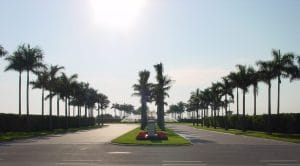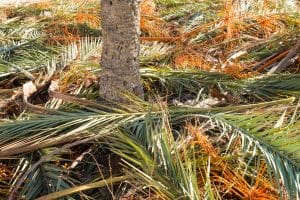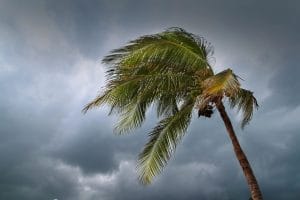Pruning for Safety: Tree Care Essentials Before Storm Season
As hurricane season approaches, ensuring that trees are properly maintained is one of the most important steps property managers and HOAs can take to protect their landscapes and surrounding structures. High winds and heavy rains can turn weak branches into dangerous projectiles, uproot unstable trees, and cause severe damage to buildings, power lines, and vehicles.
Proactive tree pruning and maintenance not only reduce these risks but also promote healthier, more storm-resistant trees. By following best practices for tree care, property owners can minimize storm damage, enhance safety, and ensure a quicker recovery after severe weather.

Why Tree Pruning is Essential Before Storm Season
Unpruned trees with weak or overgrown branches are among the leading causes of storm-related property damage. Proper pruning reduces wind resistance, strengthens tree structure, and prevents limbs from snapping under pressure.
Some key benefits of pre-storm tree pruning include:
- Reducing Wind Resistance: Thinning the canopy allows wind to pass through more easily, decreasing the chances of trees toppling.
- Eliminating Weak or Dead Branches: Removing compromised limbs prevents them from breaking off and becoming hazards during a storm.
- Improving Tree Stability: A well-balanced tree with a strong root system is less likely to be uprooted in high winds.
- Protecting Buildings and Infrastructure: Proper pruning keeps branches from hanging over roofs, power lines, and sidewalks, reducing the risk of impact damage.
Tree Pruning Tips for Storm Season
Pruning trees before hurricane season requires careful planning and proper techniques to ensure safety and effectiveness. Poor pruning practices—such as topping or over-thinning—can weaken trees, making them more susceptible to storm damage. Follow these key pruning strategies to prepare trees for severe weather.
1. Remove Dead or Weak Branches
Dead, diseased, or structurally weak branches are more likely to break during storms, causing property damage and safety hazards. Inspect trees for:
- Branches with cracks, decay, or fungal growth
- Limb attachments with weak, V-shaped crotches (prone to splitting under pressure)
- Deadwood that could easily snap in strong winds
Pruning these problem branches before storm season prevents them from becoming airborne debris during a hurricane.
2. Thin the Canopy to Reduce Wind Resistance
A dense tree canopy catches more wind, increasing the chances of branches snapping or the entire tree uprooting. Strategic thinning allows wind to pass through the tree rather than push against it like a sail.
How to Properly Thin a Tree:
- Remove selective interior branches to allow airflow.
- Avoid excessive thinning—trees still need a strong canopy for balance.
- Never remove more than 25% of the canopy at one time, as this can stress the tree.
3. Elevate Lower Branches for Clearance
Raising the lower limbs of a tree helps:
- Prevent breakage from high winds
- Keep branches from obstructing pathways and roads
- Reduce the risk of large limbs striking nearby structures
Lower branch elevation should be done gradually over time to maintain proper balance and tree health.
4. Avoid Over-Pruning or Topping
Topping (cutting off the uppermost branches of a tree) is a harmful practice that weakens trees and makes them more vulnerable to storm damage. Over-pruning, particularly removing too many branches at once, can also stress trees and reduce their ability to withstand high winds.
Why Topping Should Be Avoided:
- Weakens tree structure and encourages excessive, weak regrowth
- Reduces a tree’s ability to absorb nutrients
- Increases susceptibility to pests and diseases
Instead of topping, focus on selective pruning to improve tree strength and resilience.
Safety-Focused Tree Maintenance Before Storm Season
Beyond pruning, regular tree maintenance plays a vital role in storm preparedness. Implement these best practices to keep trees healthy and structurally sound.
1. Inspect Trees for Structural Issues
Regularly assess trees for signs of instability, such as:
- Leaning trunks – Trees that are noticeably tilting may have weak root systems and could be at risk of falling.
- Exposed roots or soil heaving – Indicates poor anchoring and potential uprooting risk.
- Large cracks in the trunk – May signal internal decay and structural weakness.
If any of these issues are present, a professional arborist should evaluate the tree’s stability.
2. Strengthen Trees with Proper Root Care
A strong root system anchors trees during storms. To encourage healthy root growth:
- Avoid overwatering, which can weaken roots.
- Apply mulch around the base to regulate soil moisture and prevent erosion.
- Aerate compacted soil to improve root expansion.
3. Secure Young and Newly Planted Trees
Young trees have shallower root systems and are more prone to being uprooted. Use flexible staking to support them while allowing some movement for natural strengthening. Be sure to remove stakes after the tree has established strong roots.
4. Choose Storm-Resistant Tree Species
Certain tree species are better equipped to withstand hurricane-force winds. If replacing or planting new trees, opt for storm-resistant varieties that are known for their strong root systems and flexible branches.
Recommended Storm-Resistant Trees for Florida Landscapes:
- Live Oak (Quercus virginiana) – Deep-rooted and highly wind-resistant.
- Sabal Palm (Sabal palmetto) – Florida’s state tree, known for its resilience in hurricanes.
- Gumbo Limbo (Bursera simaruba) – Flexible branches that resist breaking in strong winds.
- Southern Magnolia (Magnolia grandiflora) – Tolerates high winds and maintains structure.
Avoid weak-wooded trees such as laurel oaks, Australian pines, and ficus, which are prone to breakage and uprooting.
Professional Tree Care for Storm Protection
While regular pruning and maintenance can be handled seasonally, certain tree care tasks require the expertise of a professional arborist. Large trees, trees near buildings, and trees with structural concerns should always be assessed by professionals before hurricane season.
When to Call a Professional for Tree Pruning:
- If a tree is too large to safely prune without specialized equipment
- If a tree has structural damage or disease requiring expert evaluation
- If storm-resistant pruning techniques need to be applied for high-risk trees
Certified tree care professionals ensure that pruning is done safely and effectively while preserving the health of the tree.
Get Your Landscape Storm-Ready with Professional Tree Care
Taking action before hurricane season can prevent costly damage and make your property more resilient against storms. At Estate Landscaping, we specialize in professional tree pruning, structural evaluations, and storm-resistant landscape planning to protect your property from high winds and heavy rain.
Contact our team today for a pre-storm tree care assessment to ensure your landscape is safe and well-prepared for the season ahead.
Call us at 239-498-1187 or visit our Contact Us page to schedule a consultation and protect your trees before the next storm hits.
Receive a Free Consultation!
Related Posts

Proper Irrigation Maintenance During Rainy Season
As with the maintenance of any well groomed landscape, irrigation is an integral part. Especially in the tropical climate we experience here in Florida, ensuring that your lawn receives the proper amount of watering through the summer heat is vital. However, along with the heat a tropical climate brings, also comes the rain. Oftentimes, the […]

Illuminating Beauty: Enhancing Your Landscape with Outdoor Lighting
When the sun sets in Southwest Florida, your landscape doesn’t have to fade into darkness. With the right outdoor lighting ideas for landscapes, your property can transform into a stunning nighttime showcase—offering beauty, safety, and functionality. At Estate Landscaping, we believe that landscape lighting should do more than just illuminate paths; it should highlight the […]

Festive Landscapes: Enhancing Your Property for the Holidays
The holiday season is a time of joy, celebration, and togetherness. It’s also one of the best opportunities to make your property shine. Whether you manage a homeowners association, oversee a residential community, or run a commercial property, festive landscaping brings warmth and holiday spirit to every corner of your outdoor spaces. At Estate Landscaping, […]


